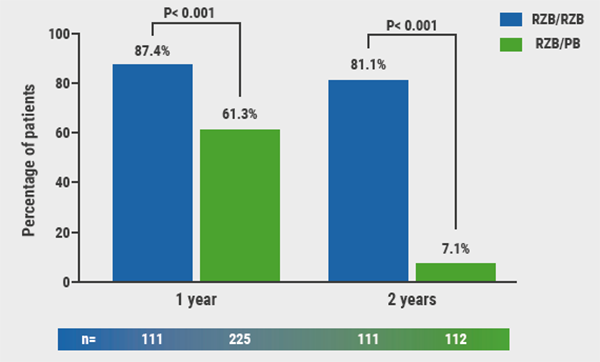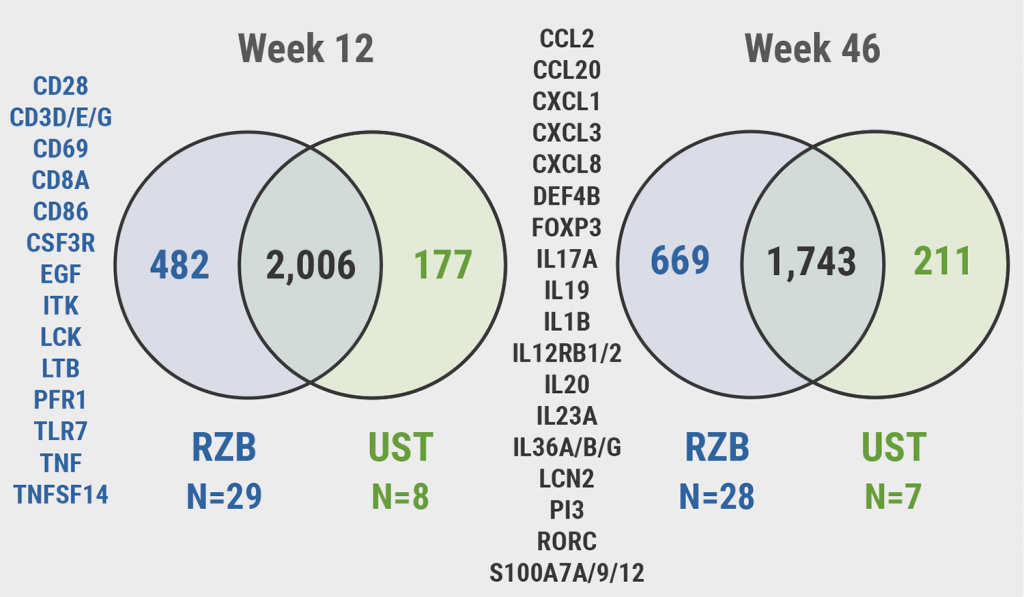Dual IL-17A/F inhibition with bimekizumab has demonstrated a meaningful benefit for patients with moderate-to-severe plaque psoriasis in various phase 3 clinical trials [1–3]. Its high efficacy is explained by its mechanisms of action (see Figure) [4]. “What happens long-term becomes the critical question,” stressed Prof. Kenneth Gordon (Medical College of Wisconsin, WI, USA). Therefore, a pooled analysis was performed of 5 phase 3 and 3b trials to assess the long-term efficacy and safety of the drug over 2 years [5]. During the initial phase 3 periods, 62.4% (n=850) of the study population on bimekizumab reached PASI100. The 86.9% of responders with a PASI of at least 90 at week 16 were enrolled in the open-label extension trials.
Figure: Mechanism of action of bimekizumab [4]
The open-label extension results were very similar between participants who stayed on the 4-weekly dosing (Q4W) and those who switched to 320 mg of bimekizumab every 8 weeks (Q8W). After 48 weeks of continuous treatment, PASI100 was preserved in 85.1% (Q4W) and 83.8% of patients (Q8W). Corresponding results of maintained Investigator Global Assessment of 0/1 after 2 years were 94.3% (Q4W) and 96.7% (Q8W). Furthermore, the rate of patients who continued to have ≤1% of body surface area affected was over 90%.
The pooled long-term safety analysis of 2,186 patients and 3,796 patient-years (PY) revealed no unexpected results. The most common treatment-emergent adverse events were nasopharyngitis (18.4/100 PY), oral candidiasis (13.0/100 PY), and upper respiratory tract infections (7.8/100 PY). Of note, 98.1% of patients with oral candidiasis reported a mild or moderate infection, and no serious cases of oral candidiasis occurred. The incidence of serious infections was low (1.2/100 PY). Overall, the Q8W regimen led to a lower proportion of adverse events than the Q4W dosing. “As the results of Q8W were so similar to Q4W we can go for this dosing interval,” Prof. Gordon said.
Prof. Gordon concluded that the clinical response rates at week 16 were maintained through 2 years of bimekizumab and the agent continued to be well tolerated with long-term use.
- Gordon KB, et al. Lancet. 2021;397(10273):475–486
- Freitas E, et al. Drugs. 2021;81(15):1751–1762.
- Reich K, et al. Lancet. 2021;397(10273):487–498.
- Adams R, et al. Front Immunol 2020;11:1894.
- Gordon KB, et al. Bimekizumab efficacy and safety through two years in patients with moderate to severe plaque psoriasis: Analysis of pooled data from five phase 3/3b clinical trials. S026, AAD 2022 Annual Meeting, 25–29 March, Boston, MA, USA.
Copyright ©2022 Medicom Medical Publishers
Posted on
Previous Article
« Novel developments in topical psoriasis therapy Next Article
New insights into psoriasis comorbidity »
« Novel developments in topical psoriasis therapy Next Article
New insights into psoriasis comorbidity »
Table of Contents: AAD 2022
Featured articles
Letter from the Editor
Lebrikizumab treatment leads to encouraging outcomes in multiple traits of AD
New Developments and Unmet Needs in Dermatology
Light at the end of the tunnel for vitiligo therapy
Intestinal microbe-preparation: Modest activity but safe for mild psoriasis
Alopecia areata: 1-year baricitinib treatment increases success
New anticholinergic preparation is effective and tolerable in hyperhidrosis
What’s Hot in Rare Diseases
Add-on apremilast may improve recalcitrant dermatomyositis
Could dupilumab put an end to the therapeutic draught in prurigo nodularis?
Fungal skin infections in children: A diagnosis to keep in mind
Innovative gel speeds up clearance of molluscum contagiosum lesions
JAK inhibition offers promising treatment prospects for uncommon dermatoses
JAK inhibitors may offer a new horizon in the treatment of sarcoidosis
Psoriasis: State of the Art
New insights into psoriasis comorbidity
Long-term psoriasis treatment with bimekizumab results in maintained efficacy
Novel developments in topical psoriasis therapy
Atopic Dermatitis: Novel Agents Enter the Stage
JAK inhibitors in AD: Setting the efficacy bar even higher
Lebrikizumab treatment leads to encouraging outcomes in multiple traits of AD
Novel IL-4/IL-13 blocker shows high efficacy with only modest conjunctivitis signal
Posters
Inpatient dermatologic therapy is linked to lower mortality and readmission rates
AD treatment during the pandemic: dupilumab does not raise COVID-19 infection risk
Upadacitinib: Fast and more pronounced skin improvement in AD patients
Dermatology diseases need the highest doses of biologics
Related Articles

August 26, 2019
Novel selective IL-23 blocker highly effective over 2 years
April 19, 2019
Serlopitant reduces pruritus associated with psoriasis

February 2, 2022
Risankizumab superior to ustekinumab in skin histopathology scores
© 2024 Medicom Medical Publishers. All rights reserved. Terms and Conditions | Privacy Policy

